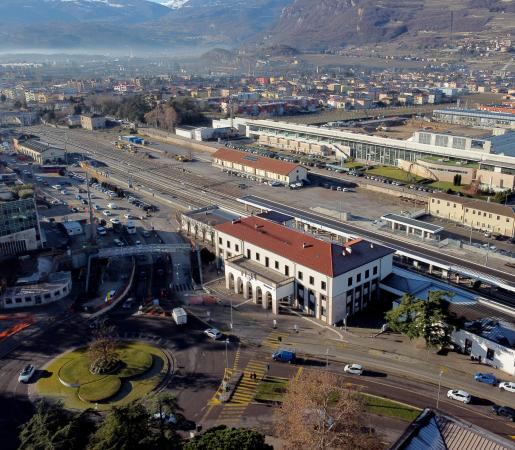
Rovereto
S4T - Station for Transformation
About the project
The Alpine town of Rovereto and its surrounding commuter zone face the challenge of rapidly adapting to the effects of climate change and mitigating the resulting loss of biodiversity, which is closely linked to the local territorial cultural heritage. To address this challenge, Rovereto is transforming the empty main building of its train station, and the land around it, into a public-civic hub for joint actions linked to climate change, biodiversity loss and heritage regeneration. The centrality of the train station, already a key mobility hub for over 135 000 inhabitants, makes it an ideal public space for the co-creation of a territorial ‘think and action’ tank.
For the first time, a railway station is being transformed from a transportation hub into a multiplier and catalyst to support the local community in facing contemporary challenges. In this way, the station's historical importance for local development and identity is regenerated by turning it into a cross-border cohesion hub.
To activate the local station's potential, Rovereto is piloting a new hub, including: a Biodiversity Kiosk; a Climate and Biodiversity Co-creation space; a Climate Canteen; a Climate and Biodiversity Community Space; and an outreach device ‘S4T on Wheels’.
These spaces will serve as interactive venues for training, co-design, co-production and knowledge transfer. They will support promising public, civic and economic initiatives linked to climate change and biodiversity.
This model can also be replicated in other communities.
Challenges
The challenge S4T tackles is the need to guarantee and improve quality of life for all urban dwellers by regenerating and transforming the cultural heritage of the territory in face of mounting climate and biodiversity challenges, and transform local practices to improve the area’s level of sustainability.
-
Rovereto’s functional urban area is experiencing rapidly escalating effects of climate change – such as water scarcity and shortages, heat islands, forest fires, extreme winds – which also threaten biodiversity.
-
Rovereto’s urban area is located in the Italian Alps. This region's adaptive capacity to climate change has been rated as dramatically low at the infrastructural, technological and institutional levels, and in terms of knowledge and awareness.
-
Climate change is a particular threat in the Alps, Europe's second largest biodiversity reservoir. Here, 13 000 plant and 30 000 animal species share their environment with 14 million human residents and about 120 million visitors per year.
Proposed solutions
This solution involves transforming a central railway station into a vibrant public-civic hub to catalyse innovative, inclusive and regenerative actions. Helping stakeholders tackle their territory’s climate and biodiversity challenges together, S4T embraces core values and working principles of the New European Bauhaus. This novel collaboration between public administrators and citizens supports the reinvention of green, inclusive and cohesive lifestyles, starting from local heritage.
-
Transgenerational and multidisciplinary knowledge transfer encourages the territorial exchange of novel solutions to tackle climate and biodiversity challenges. S4T is developing co-sharing, co-creation and outreach actions for extended inclusivity.
-
This sustainable solution includes the design and realisation of new spaces reflecting New European Bauhaus principles, and specific Environmental Social Governance and Territorial Impact Assessment-based monitoring environmental impact actions.
-
S4T offers adaptive, validated and replicable models involving local pilot actions, training to develop new skills, biodiversity dissemination actions, and digital simulations to facilitate adoption and replication of solutions in other urban settings.
-
The S4T public-civic hub will be replicated by the project’s Transfer partners and the RFI (Italian Rail Network) in other mobility hubs, helping implement Cohesion policy beyond the end of the project and in other urban areas across the EU.
Milestones
Analysis of relevant ongoing projects and a programme of clustering actions
Kick-off event at the station with partners, stakeholders, potential beneficiaries and media
An innovative New European Bauhaus-designed regenerated hub for public-civic actions, including multiple spaces and an outreach module
The best applicable methodology for a collaboration led by public-civic organisations
A replication strategy extended to diverse ecosystems, based on simulated, modelled, and validated data